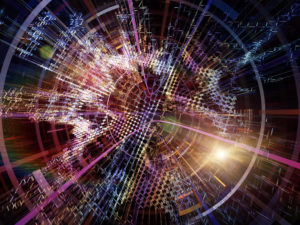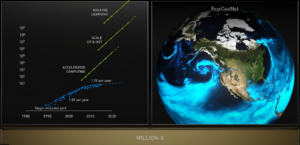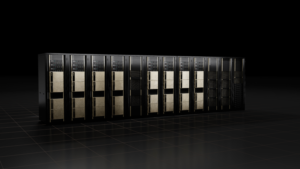
Nvidia CEO Touts a ‘Million X’ Speedup in AI

A decade ago, Google talked about “thinking in 10x.” Whether it’s Moore’s Law or the current rate of inflation, Nvidia’s CEO Jensen Huang has one-upped his fellow Silicon Valley technologists by thinking in million X. According to Huang, it will have a monumental impact on biology and chemistry in the near future.
Huang used a good deal of his one-hour-and-42 minute keynote at Nvidia’s GPU Technology Conference (GTC) this morning to tout the company’s latest GPU architecture, dubbed the H100 Hopper. Built on a thinner 4 nanometer process and featuring 80 billion transistors (68% more than the previous generation A100 GPU), the Hopper immediately becomes the premiere processor to run AI workloads.
The new systems Nvidia is building with Hopper are mind-blowing in their own right, and you can read all about them at HPCWire, which is Datanami’s sister publication. But Huang also spent time discussing the breakthroughs that computing advances over the past decade have had out in the field.
For example, the capability to sequence human DNA in less than an hour is new, and so is the advent of deep learning systems that have an uncanny capability to understand human text and recognize faces. Perhaps it’s not surprising that Nvidia, the undisputed leader in GPUs, had a hand in making these happen.
“None of these capabilities were remotely possible a decade ago,” Huang said. “Accelerated computing, at data center scale and combined with machine learning, has sped up computing by a million X.”
From large transformer models, like GPT AI, to self-supervised learning algorithms, AI has fundamentally changed how we make software, and what software can do, Huang said. It has also given rise to “AI factories,” where companies manufacture intelligence from raw data. But thanks to the million x growth, we are on the cusp of something bigger and new, he said.
“The first wave of AI learned perception and inference, like recognizing images, understanding speech, recommending a video or an item to buy,” Huang said. “The next wave of AI is robotics, AI planning actions. Digital robots, avatars and physical robots will proceed, plan and act. And just as AI frameworks like TensorFlow and PyTorch have become integral to AI software, Omniverse will be essential to making robotic software.”
Huang spent a considerable amount of time talking about scientific applications of the Nvidia stack, which stems from the CUDA libraries at the heart of the company’s software development kits and the software for managing AI models to the actual GPUs that are used to train the AI models.
“With each new SDK, new science, new applications, and new industries can tap into the power of Nvidia computing,” Huang said. “These SDKs tackle the immense complexity at the intersection of computing, algorithms, and science. The compound effect of Nvidia’s full stack approach resulted in a million x speedup.”
Nvidia isn’t the only company participating in the AI revolution. To be sure, the company has plenty of competition at all levels of the stack. But there’s no doubt that Nvidia has played a central role in developing many of the components that are popular today.

Nvidia has delivered a million X increase in processing power over the past decade, CEO Jensen Huang says
For Huang, the math is simple: build bigger and better GPUs that enable customers to process ever-bigger piles of data into insight that gives you an advantage. In that respect, passing the “million X” mark may be just one more predictable milestone on a journey that some say we are just beginning.
“The progress of AI is stunning,” Huang continues. “Transformers open self-supervised learning and unblocked the need for human-labeled data. We can use enormous training sets with transformers and learn more robust and more complete representations.”
The benefits from this million-x thinking accrued to different players. Near the top of the list are consumers, who benefit from better search engines, voice recognition systems, and facial recognition systems. It benefits the big tech firms with market caps that exceed $1 trillion (Nvidia approached an $800 billion market cap in December before its stock pulled back a bit in early 2022).
But before long, AI’s benefits will start to accrue to some of the most vulnerable among us, including those who suffer from rare diseases like pulmonary fibrosis. That’s the disease that an Nvidia customer called Insilico Medicine developed a drug candidate for using AI techniques. It is set to start human trials soon.
“The novel drug and target [were] discovered in less than 18 months, years faster than previously possible,” Huang said. “The conditions are prime for the digital biology revolution. I can’t imagine a greater purpose for Nvidia AI.”
We’re now embarking upon the “next generation” of AI, and the changes will come quickly, Huang said. The advent of self-learning transformers helped AI “to jump to warp speed.”
“AI is racing in every direction–new architectures, new learning strategies, larger and more robust models, new science, new applications, new industries–all at the same time,” Huang said. “The GPU revolutionized AI. Now AI on GPUs is revolutionizing industries and science…The conditions are prime for significant breakthroughs in science.”
Another example is FourCastNet, a new AI-based weather prediction model designed to move the bar forward on hard-to-predict events, such as atmospheric rivers. “For the first time, a deep learning model has achieved better accuracy and skill on precipitation forecasting then state of the art numerical models,” Huang said. “It makes predictions four to five orders of magnitude faster. What takes a classical numerical simulation a year, now takes minutes.”
With massive new GPU systems like Hopper promising to form the foundation for “AI supercomputers” capable of processing ever-larger piles of data, it may not be wise to bet against Huang. Even if he’s wrong about Nvidia being the center of it, the AI revolution will continue.
For now, Huang can bask in the glory. “Over the past decade, Nvidia accelerated computing delivered a million x speedup in AI and started the modern AI revolution,” Huang said. “Now AI will revolutionize all industries.”
Related Items:
Nvidia Bolsters Edge AI and Autonomous Robots at GTC 2022
Nvidia Launches Hopper H100 GPU, New DGXs and Grace Megachips
Thinking in 10x and Other Google Directives





























